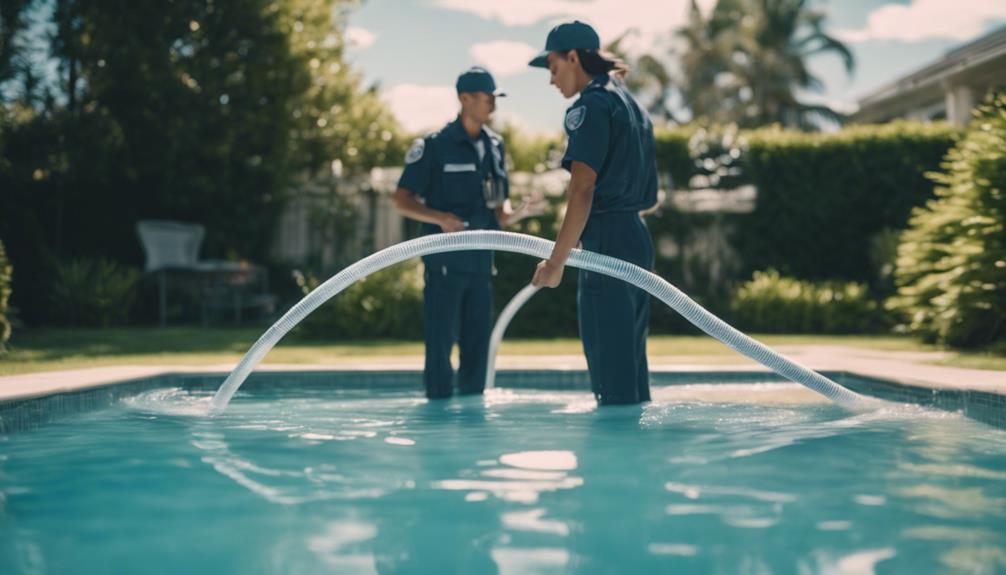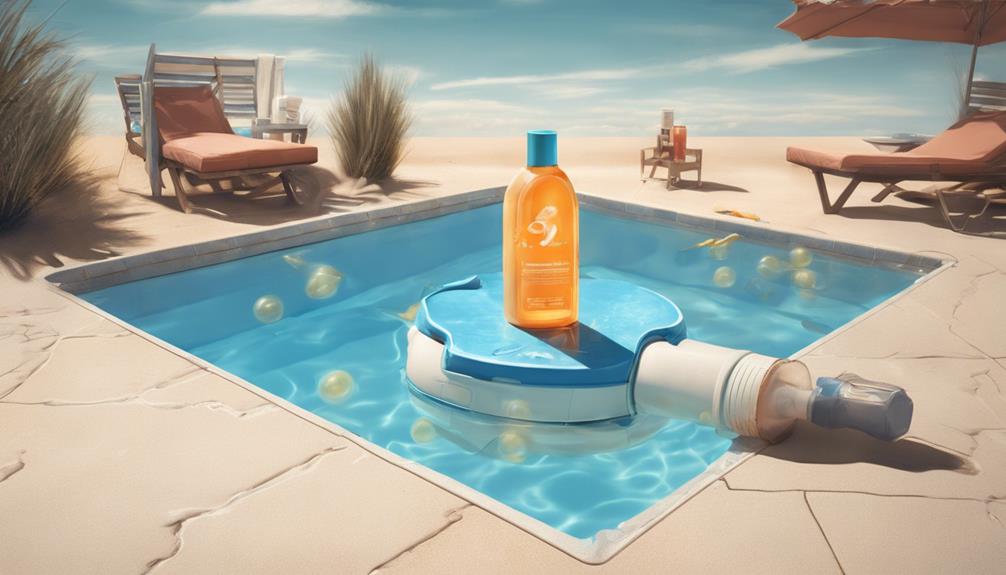Children should consistently walk, not run, around the pool to prevent slipping accidents. Diving should only be attempted in water deeper than 8 feet to minimize the risk of injuries. Adult supervision is crucial to ensure a safe pool environment. Implementing the buddy system provides an additional level of safety and fosters camaraderie. Furthermore, regularly applying sunscreen with SPF 30 every two hours helps to shield against harmful UV rays. These guidelines are essential for safeguarding the well-being and safety of children at the pool.
Key Takeaways
- Walk, don't run, around the pool to prevent slipping accidents.
- Avoid diving in shallow pools; water should be at least 8 feet deep.
- Always swim with a buddy for added safety and support.
- Apply SPF 30 sunscreen and reapply every 2 hours for sun protection.
- Adult supervision is crucial for a secure pool environment.
Walking Safety Tips
Promoting walking as a preventive measure is paramount to ensuring pool safety for children. Wet pool areas are inherently slippery, making running a risky activity that can lead to accidents. By encouraging children to walk around the pool, the risk of slipping and sustaining injuries is notably reduced.
It is essential for kids to understand the importance of walking in and around pool areas to prioritize safety above all else. Implementing strict rules and guidelines that advocate for walking, rather than running, can instill a culture of safety and caution.
Diving Safety Guidelines
Emphasizing the significance of safe diving practices is vital for maintaining a secure pool environment for children. Diving in shallow pools can lead to severe injuries, making it important to avoid diving in water less than 8 feet deep.
Encouraging children to perform feet-first jumps and introducing alternative jumps like cannonballs can enhance safety. Prioritizing safety over thrill-seeking is crucial when it comes to diving.
Importance of Supervision

With safety being of utmost importance around the pool, adult supervision plays a key role in guaranteeing a secure environment for children engaging in water activities. Even good swimmers need supervision as accidents can happen unexpectedly.
Swimming alone poses risks, making parental supervision non-negotiable. Adults should be vigilant, maintaining a constant watch over children in and around the pool. Supervision ensures immediate response in case of emergencies, such as drowning or injuries.
Buddy System Benefits
Utilizing the buddy system enhances safety measures and promotes a more secure environment for children during pool activities.
Swimming with a buddy provides an additional layer of safety by ensuring there is always a second set of eyes to monitor each other's well-being in the water. In the event of an emergency, a buddy can quickly seek help or provide assistance.
Additionally, swimming with friends encourages camaraderie and fosters a sense of responsibility towards each other's safety.
The buddy system also reinforces the concept of safety in numbers, reducing the risk of accidents or getting into dangerous situations alone.
Ultimately, swimming with a buddy not only increases safety but also makes pool activities more enjoyable and social for children.
Sun Protection Essentials

Swimming under the sun necessitates strict adherence to sun protection measures to safeguard against skin damage and related health risks. It is imperative for children engaging in pool activities to apply sunscreen with a minimum SPF of 30, even on cloudy days, to shield their skin from harmful UV rays.
Sunscreen should be reapplied every two hours, especially after swimming or sweating. Additionally, wearing protective clothing such as UV-blocking swimwear, sunglasses, and hats can provide added defense against sunburn and long-term skin issues.
Parents and caregivers should instill the habit of sun protection in children from a young age to promote lifelong skin health and reduce the risk of sun-related ailments.
Frequently Asked Questions
Can Children Wear Floatation Devices in the Pool?
Children can wear floatation devices in the pool for added safety and buoyancy. However, adult supervision is still necessary. Make sure the devices are properly fitted and approved for water use. Always prioritize safety when allowing children to use floatation devices.
What Should Kids Do if They See Someone Struggling in the Water?
'Actions speak louder than words. If kids see someone struggling in the water, they should immediately call for help and not attempt a rescue themselves. Alerting a lifeguard or adult is essential for ensuring safety.'
Are Pool Toys Like Inflatable Rings Safe for Children?
Inflatable rings can be fun for children but require supervision. Verify correct sizing for a secure fit. Watch for deflation or tears that could pose a drowning risk. Always prioritize safety when using pool toys.
How Can Parents Teach Kids to Recognize Pool Depth?
Teaching kids to recognize pool depth involves explaining the correlation between water depth and safety. Parents can visually demonstrate different depths, use markers, and discuss the risks associated with diving in shallow water to instill awareness and caution.
Should Children Be Discouraged From Diving in Public Pools?
Children should be discouraged from diving in public pools due to safety concerns. Diving in shallow water or pools less than 8 feet deep can lead to serious injuries. Safety should always be the top priority.
What Are the Essential Pool Safety Guidelines for Children?
When it comes to pool safety for children, following pool inspection safety value guidelines is crucial. Always ensure proper fencing, secure pool covers, constant adult supervision, and CPR training. Teach kids basic swimming skills, and invest in flotation devices. Enforce rules and educate kids on the importance of pool safety.
What Are the Key Pool Safety Guidelines that Should be Checked During a Pool Inspection?
During a pool inspection safety and value should be top priorities. Key guidelines to check include proper fence and gate installation, functioning safety covers, non-slip surfaces, and secure ladders. Additionally, inspect water quality, proper equipment maintenance, and ample signage for rules and emergency information.
Are Green Algae in Pools a Sign of Unsafe Conditions for Children?
Parents often have safety concerns about green water in pools, especially when it comes to children. Green algae can indicate unsafe conditions, including improper chemical balance and poor maintenance. It is crucial to address these issues promptly to ensure a safe and healthy swimming environment for kids.
How Can Proper Pool Heater Operation Ensure Child Safety in the Pool?
When it comes to ensuring child safety in the pool, understanding how to properly operate your pool heater is crucial. By taking the time to discover pool heater operation secrets, you can maintain optimal water temperature which reduces the risk of hypothermia and keeps children safe and comfortable while swimming.
How Does Chemical Storage Safety Relate to Pool Safety Guidelines for Children?
When it comes to pool safety for children, following vital chemical storage guidelines is crucial. Proper storage of pool chemicals can prevent accidental exposure and mishandling, which can lead to serious injuries. By adhering to these guidelines, parents can create a safe environment for their children to enjoy the pool.
How Can Chemical Storage Safety Guidelines Also Apply to Pool Safety for Children?
When it comes to pool safety for children, applying vital chemical storage guidelines is crucial. Keeping pool cleaning chemicals out of reach, locked away, and properly labeled can prevent accidental poisoning or injury. By following the same safety protocols as with other chemicals, parents can help ensure a safe pool environment for their kids.
Conclusion
To sum up, adherence to pool safety guidelines is essential for ensuring the well-being of children in aquatic settings. By following walking safety tips, diving precautions, supervision protocols, the buddy system, and sun protection essentials, a culture of responsibility and awareness can be cultivated.
These measures not only help reduce risks of accidents and injuries but also promote a positive and enjoyable experience for all participants, creating a safe environment for children to enjoy aquatic activities.










